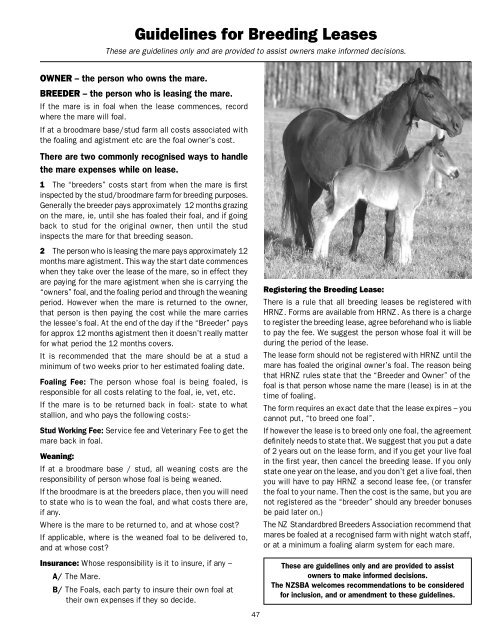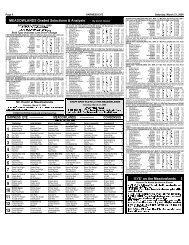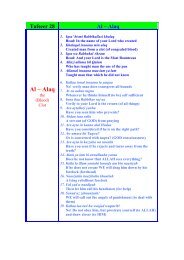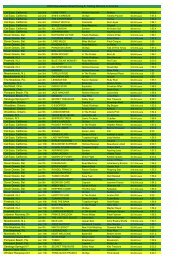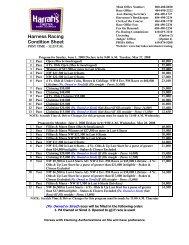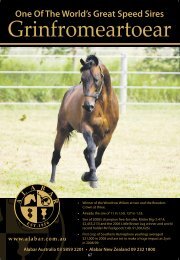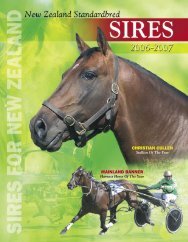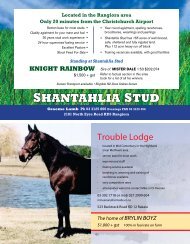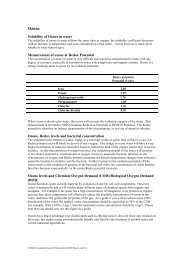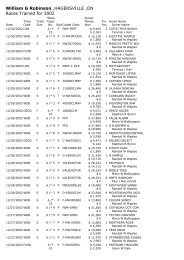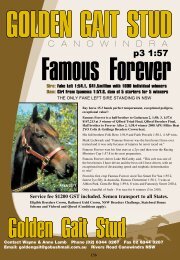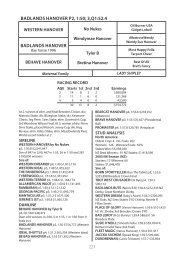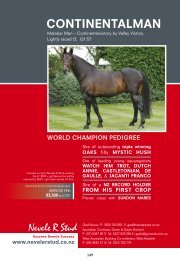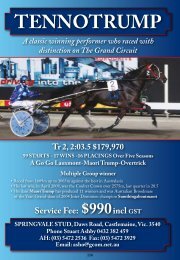Christian Cullen - Harnesslink
Christian Cullen - Harnesslink
Christian Cullen - Harnesslink
You also want an ePaper? Increase the reach of your titles
YUMPU automatically turns print PDFs into web optimized ePapers that Google loves.
Guidelines for Breeding Leases<br />
These are guidelines only and are provided to assist owners make informed decisions.<br />
OWNER – the person who owns the mare.<br />
BREEDER – the person who is leasing the mare.<br />
If the mare is in foal when the lease commences, record<br />
where the mare will foal.<br />
If at a broodmare base/stud farm all costs associated with<br />
the foaling and agistment etc are the foal owner’s cost.<br />
There are two commonly recognised ways to handle<br />
the mare expenses while on lease.<br />
1 The “breeders” costs start from when the mare is first<br />
inspected by the stud/broodmare farm for breeding purposes.<br />
Generally the breeder pays approximately 12 months grazing<br />
on the mare, ie, until she has foaled their foal, and if going<br />
back to stud for the original owner, then until the stud<br />
inspects the mare for that breeding season.<br />
2 The person who is leasing the mare pays approximately 12<br />
months mare agistment. This way the start date commences<br />
when they take over the lease of the mare, so in effect they<br />
are paying for the mare agistment when she is carrying the<br />
“owners” foal, and the foaling period and through the weaning<br />
period. However when the mare is returned to the owner,<br />
that person is then paying the cost while the mare carries<br />
the lessee’s foal. At the end of the day if the “Breeder” pays<br />
for approx 12 months agistment then it doesn’t really matter<br />
for what period the 12 months covers.<br />
It is recommended that the mare should be at a stud a<br />
minimum of two weeks prior to her estimated foaling date.<br />
Foaling Fee: The person whose foal is being foaled, is<br />
responsible for all costs relating to the foal, ie, vet, etc.<br />
If the mare is to be returned back in foal:- state to what<br />
stallion, and who pays the following costs:-<br />
Stud Working Fee: Service fee and Veterinary Fee to get the<br />
mare back in foal.<br />
Weaning:<br />
If at a broodmare base / stud, all weaning costs are the<br />
responsibility of person whose foal is being weaned.<br />
If the broodmare is at the breeders place, then you will need<br />
to state who is to wean the foal, and what costs there are,<br />
if any.<br />
Where is the mare to be returned to, and at whose cost?<br />
If applicable, where is the weaned foal to be delivered to,<br />
and at whose cost?<br />
Insurance: Whose responsibility is it to insure, if any –<br />
A/ The Mare.<br />
B/ The Foals, each party to insure their own foal at<br />
their own expenses if they so decide.<br />
47<br />
Registering the Breeding Lease:<br />
There is a rule that all breeding leases be registered with<br />
HRNZ. Forms are available from HRNZ. As there is a charge<br />
to register the breeding lease, agree beforehand who is liable<br />
to pay the fee. We suggest the person whose foal it will be<br />
during the period of the lease.<br />
The lease form should not be registered with HRNZ until the<br />
mare has foaled the original owner’s foal. The reason being<br />
that HRNZ rules state that the “Breeder and Owner” of the<br />
foal is that person whose name the mare (lease) is in at the<br />
time of foaling.<br />
The form requires an exact date that the lease expires – you<br />
cannot put, “to breed one foal”.<br />
If however the lease is to breed only one foal, the agreement<br />
definitely needs to state that. We suggest that you put a date<br />
of 2 years out on the lease form, and if you get your live foal<br />
in the first year, then cancel the breeding lease. If you only<br />
state one year on the lease, and you don’t get a live foal, then<br />
you will have to pay HRNZ a second lease fee, (or transfer<br />
the foal to your name. Then the cost is the same, but you are<br />
not registered as the “breeder” should any breeder bonuses<br />
be paid later on.)<br />
The NZ Standardbred Breeders Association recommend that<br />
mares be foaled at a recognised farm with night watch staff,<br />
or at a minimum a foaling alarm system for each mare.<br />
These are guidelines only and are provided to assist<br />
owners to make informed decisions.<br />
The NZSBA welcomes recommendations to be considered<br />
for inclusion, and or amendment to these guidelines.


